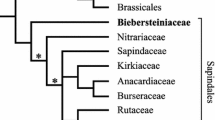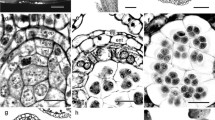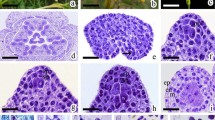Abstract
The embryology ofStegnosperma halimifolium andS. watsonii has been studied in detail. The tapetum is of the secretory type and its cells become multinucleate. Simultaneous cytokinesis in the pollen mother cells follows meiosis. The ripe pollen grains are 3-celled. The ovule is crassinucellate, bitegmic and amphitropous, with the micropyle formed by the inner integument alone. The female archesporium is one celled, and the parietal tissue 3–5 layered. The embryo sac development conforms to thePolygonum type. A central strand, 6 or 7 cells thick, differentiates inside the nucellus and extends from the base of the embryo sac to the chalazal region. The endosperm is nuclear. The embryogeny conforms to the Caryophyllad type. The seed coat is formed by the outer epidermis of the outer integument and the inner epidermis of the inner integument. Based on this evidence and other data, the status of the genus as an independent family,Stegnospermataceae (Stegnospermaceae) is confirmed. Apparently, it forms a connecting link betweenPhytolaccaceae andCaryophyllaceae.
Similar content being viewed by others
References
Airy Shaw, H. K., 1973: InWillis, J. C.: A Dictionary of the Flowering Plants and Ferns. 8th ed. — Cambridge: Cambridge University Press.
Bedell, H. G., 1980: A taxonomic and morphological re-evaluation ofStegnospermaceae (Caryophyllales). — Syst. Bot.5, 419–431.
Behnke, H.-D., 1976: Ultrastructure of sieve-element plastids inCaryophyllales (Centrospermae), evidence for the delimitation and classification of the order. — Pl. Syst. Evol.126, 31–54.
Bortenschlager, S., 1973: Morphologie pollinique desCaryophyllaceae. — Pollen & Spores15, 227–253.
Chaudary, I. P., Narayana, H. S., 1978: Studies on the development and structure of seed in theCaryophyllales. — I.Spergula arvensis L. — J. Indian Bot. Soc.57, 46–52.
Corner, E. J. H., 1976: The Seeds of Dicotyledons. — Cambridge: Cambridge University Press.
Cronquist, A., 1981: An Integrated System of Classification of Flowering Plants. — New York: Columbia University Press.
Dahlgren, R., 1983: General aspects of angiosperm evolution and macrosystematics. — Nordic J. Bot.3, 119–149.
Davis, G. L., 1966: Systematic Embroyology of the Angiosperms. — New York: John Wiley & Sons.
Engler, A., Prantl, K., 1931: Die Natürlichen Pflanzenfamilien. — Leipzig: Engelmann.
Erdtman, G., 1971: Pollen Morphology and Plant Taxonomy. — New York: Hafner Publishing Co.
Friedrich, H. C., 1956: Studien über die natürliche Verwandtschaft derPlumbaginales undCentrospermae. — Phyton6, 220–263.
Gibbs, R. D., 1974: Chemotaxonomy of Flowering Plants. Vol. III. — London: McGill Queen's University Press.
Heywood, V. H., 1979: Flowering Plants of the World. — London: Oxford University Press.
Hooker, J. D., 1980:Phytolaccaceae. — InBentham, G., Hooker, J. D., (Eds.): Genera Plantarum3, pp. 78–87. — London: L. Reeve & Co.
Horak, K. E., 1981: Anomalous secondary thickening inStegnosperma (Phytolaccaceae). — Bull. Torrey Bot. Club108, 189–197.
Hutchinson, J., 1973: The Families of Flowering Plants. — London: Oxford University Press.
Johansen, D. A., 1950: Plant Embryology. — Waltham, Mass., U.S.A.
Joshi, A. C., Rao, V. S., 1933: Floral anatomy ofRivina humilis L. and the theory of carpel polymorphism. — New Phytol.32, 359–363.
Kajale, L. B., 1954: A contribution to the embryology of thePhytolaccaceae. — II.Rivina humilis L. andPhytolacca dioica L. — J. Indian Bot. Soc.33, 206–225.
Kamelina, O. P., 1983:Stegnospermataceae. – InYakovlev, M. S., (Ed.): Comparative Embryology of Flowering Plants, pp. 284–285. — Leningrad: Nauka.
Lawrence, G. H. M., 1951: Taxonomy of Vascular Plants. — Calcutta: Oxford & IBH Publishers Co.
Mabry, J. T., 1977: The orderCentrospermae. — Ann. Missouri Bot. Gard.64, 210–220.
Metcalfe, C. R., Chalk, L., 1950: Anatomy of the Dicotyledons I. — London: Oxford University Press.
Mikesell, J. E., 1979: Anomalous secondary thickening inPhytolacca americana L. (Phytolaccaceae). — Amer. J. Bot.66, 997–1005.
Nakai, T., 1942: Notulae ad Plantae Asiae Orientalis (XVIII). — J. Jap. Bot.18, 91–120.
Narayana, L. L., Suvartha, C., 1984: Floral anatomy ofStegnospermataceae. — Acta Bot. Indica12, 207–2:09.
Pal, S., Murthy, Y. S., 1972: Structure and development of female gametophyte and embryo inStellaria aquatica Scop. — J. Indian Bot. Soc.51, 232–234.
, 1974: A contribution to the embryology ofStellaria paniculata Edgew. — J. Indian Bot. Soc.53, 288–292.
Skvarla, J. J., Nowicke, J. W., 1976: Ultrastructure of pollen exine in centrospermous families. — Pl. Syst. Evol.126, 55–76.
Suvartha, C., Narayana, L. L., 1981: Floral anatomy ofStegnosperma halimifolium Benth. — Curr. Sci.50, 138–139.
Takhtajan, A. L., 1980: Outline of the classification of flowering plants (Magnoliophyta). — Bot. Rev. (Lancaster)46, 225–359.
Thomson, B. E., 1942: The floral morphology ofCaryophyllaceae. — Amer. J. Bot.29, 333–349.
Thorne, R. F., 1983: Proposed new realignments in the angiosperms. — Nordic J. Bot.3, 85–117.
Wheat, D., 1977: Successive cambia inPhytolacca dioica. — Amer. J. Bot.64, 1209–1217.
Author information
Authors and Affiliations
Rights and permissions
About this article
Cite this article
Narayana, P.S., Narayana, L.L. The embryology ofStegnospermataceae, with a discussion on its status, affinities and systematic position. Pl Syst Evol 154, 137–145 (1986). https://doi.org/10.1007/BF00984874
Received:
Issue Date:
DOI: https://doi.org/10.1007/BF00984874




